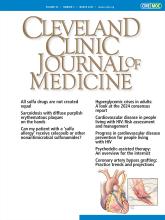To the Editor: We read with great interest the commentary on improving access to antiobesity medications by Dr. Burguera and colleagues published in the November 2024 issue.1 This article highlighted the plague of unequal and inadequate access to the new glucagon-like peptide (GLP) 1 and dual glucose-dependent insulinotropic polypeptide and GLP-1 receptor agonist medications for weight loss. We would like to echo and highlight the lack of access to these medications in patients awaiting organ transplants.
Obesity is a leading risk factor for chronic kidney disease, metabolic dysfunction–associated steatotic liver disease (formerly known as nonalcoholic fatty liver disease), and congestive heart failure. Studies have shown that patients with obesity have a lower likelihood of being listed and undergoing a kidney transplant.2 There are about 90,000 patients awaiting a kidney transplant, and 17 people die each day in the United States while awaiting an organ transplant.3 Obesity in patients who have undergone renal transplant has been associated with a higher risk of delayed graft function, wound dehiscence, allograft rejection and loss, posttransplant diabetes, and cardiovascular disease.2,4
Burguera and colleagues1 outlined the cost differences for these medications between countries, with individuals in some countries paying as much as 75% less for them. Insurance coverage and pricing in the United States have amplified the inequalities in access in our healthcare system, as some insurance companies have limited their coverage and expanded prior authorization requirements in an effort to reduce the number of patients eligible for these medications.5 This further exacerbates disparities in access to solid-organ transplants, and particularly affects those who are already at a disadvantage in our healthcare system.
We add our voices to those of Dr. Burguera and colleagues1 in a call to action to expand coverage and affordability of these medications as our patients’ lives are at stake.
- Copyright © 2025 The Cleveland Clinic Foundation. All Rights Reserved.






